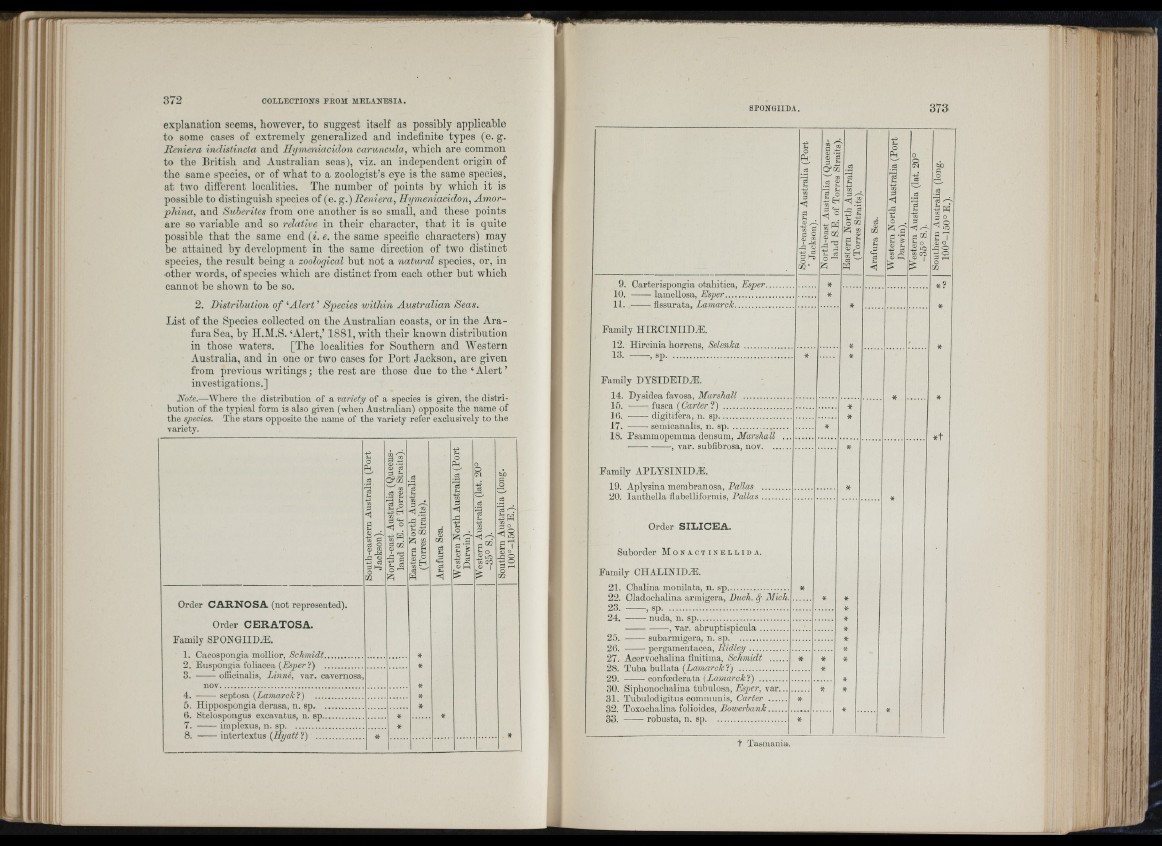
I;: I!.
•<:: -
lit -
1:
tü
-4f1f1i
l1i' ' ii ..
1'":^ ;
i i -
explanation seems, however, to suggest itself as possibly applicable
to some cases of extremely generalized and indefinite types (e. g.
Reniera indistincta aud Hymeniacidon carúncula, which are common
to the British and Australian seas), viz. an independent origin of
the same species, or of what to a zoologist’s eye is the same species,
at two different localities. The number of points by which it is
possible to distinguish species of (e. g.) Reniera, Hymeniacidon, Amor-
qJiina, and Suberites from one another is so small, and these points
are so variable and so relative in their character, th at it is quite
possible th a t the same end {i. e. the same specific characters) may
be attained by development in the same direction of two distinct
species, the result being a zoological bnt not a natural species, or, in
■other words, of species which are distinct from each other hut which
cannot be shown to be so.
2. Distribution of ‘Alert ’ Species within Australian Seas.
List of the Species collected on the Australian coasts, or in the Arafura
Sea, by H.M.S. ‘Alert,’ 1881, with their known distribution
in those waters. [The localities for Southern and "Western
Australia, and in one or two cases for Port Jackson, are given
from previous writings; the rest are those due to the ‘ Alert ’
investigations.]
Note.—Where the distribution of a variety of a species is given, the distribution
of the typical form is also given (when Australian) opposite the name of
the species. The stars opposite the name of the variety refer exclusively to the
variety.
ri
aU
fl
§T .!g<(
Í §
02
Order C ARNOS A (not represented).
Order CERATOSA.
Family SPONGIIDA.
1. Cacospongia mollior, Schmidt.........
2. Euspongia foliácea {Esper ?)
3. officinalis, Linné, var. cavernosa.
Cfl? cho 02
S £
t ñ
4- septosa {Lamarck ? )
5. Hippospongia derasa, n. sp.
6. Stelospongus excavatus, n. sp.,
7. implexus, n. sp................
8. intertextus {Hyatt ?) ...
S
02 3 —■
r i ^
tëi æti
« ^
tSi ^h cS
mta
cS
ri
3
ri
o .
S'S
ti s
O
tip
fl °
ri {Sp o *
- f l o o3 2 02
t Tasmania.
-1.3
0
S-I
QÍ i ^
f02l +
O'iz
Ia. -fl £
3> tc,i
' "oe
0
.S
"cö
'OQ
0S
CÒJO 0
m
g A
ti'^
ri
i t iH
gæ
A V
t0i ^S
"tc Cfl m rC
Ï -g
> 3 ^
i ^
; ' 0 ^
Í!1
; cé
Ä §
I I
S
' g
ri
fl
“3S-i 0
t(rii cS
'S 5
?
. "fml
! ^ OQ
tfli «0
i l
l0§ 02
9. Carterispongia otahitica, Esper.......... * it?
10. ----- lamellosa, Esper............................ *
11. ----- fissurata, Lamarck........................ it if
Family HIECINIIHÆ.
12. Hircinia horrens, Selenka ................. it if
13. ------, sp.......................... .......... It it
Family DYSIDEIDÆ.
14. Dysidea favosa, Marshall ................... •if ■if
15 ----- fusca (Carter‘s) jf.
16 ----- digitifera, n sp if.
17. ----- semicanalis, n. sp......................... *
18. Psammopemma densum, Marshall
----- ------ J vV aCV.Mr- • skOi LiXÌ jfAì-ibKfB Â. Uo/ws OaU J yJJìLcV/i vT*
Family APLYSINIDÆ.
7k
19. Aplysina membranosa, PaUas ........... *
20. lanthella flabelliformis, Pallas........... it
Order SILICEA.
Suborder Monactinellida.
Family CHALINIDÆ.
21. Chalina monilata, n. sp........................
22. Cladochalina armigera, Duch. ÿ Mich.
23 sp
* * it
24 ----- nuda n. sn. . .... . . . if.
va,r abruntisniciila if
2 5 ----- sub.armig'era li sd. . . if
26 ----- pergamentacea, Hidlcy.................. if
27. Acervocbalina finitima, Schmidt .......
* *
it
28 Tuba bullata ? 1 .............
it
99 .. confoederata iI.i(xmciTclcT\ if
30. Siphonochalina tubulosa, var...
it it
31. Tubulodigitus communis, Carter .......
*
32. Toxochalina folioides, Bowerhank.........
* if
- ro b u s ta n sd
! ' ' i k
IM.
II i;
Mi l
1 !
< I
Mi
r